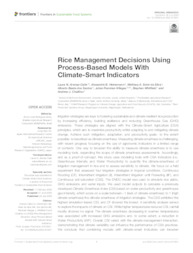Rice management decisions using process-based models with climate-smart indicators.
Rice management decisions using process-based models with climate-smart indicators.
Author(s): ARENAS-CALLE, L. N.; HEINEMANN, A. B.; SILVA, M. A. S. da; SANTOS, A. B. dos; RAMIREZ-VILLEGAS, J.; WHITFIELD, S.; CHALLINOR, A. J.
Summary: Irrigation strategies are keys to fostering sustainable and climate-resilient rice production by increasing efficiency, building resilience and reducing Greenhouse Gas (GHG) emissions. These strategies are aligned with the Climate-Smart Agriculture (CSA) principles, which aim to maximize productivity whilst adapting to and mitigating climate change. Achieve such mitigation, adaptation, and productivity goals- to the extent possible- is described as climate smartness. Measuring climate smartness is challenging, with recent progress focusing on the use of agronomic indicators in a limited range of contexts. One way to broaden the ability to measure climate-smartness is to use modeling tools, expanding the scope of climate smartness assessments. Accordingly, and as a proof-of-concept, this study uses modeling tools with CSA indicators (i.e., Greenhouse Intensity and Water Productivity) to quantify the climate-smartness of irrigation management in rice and to assess sensitivity to climate. We focus on a field experiment that assessed four irrigation strategies in tropical conditions, Continuous Flooding (CF), Intermittent Irrigation (II), Intermittent Irrigation until Flowering (IIF), and Continuous soil saturation (CSS). The DNDC model was used to simulate rice yields, GHG emissions and water inputs. We used model outputs to calculate a previously developed Climate-Smartness Index (CSI) based on water productivity and greenhouse gas intensity, which score on a scale between - 1 (lack of climate-smartness) to 1 (high climate smartness) the climate-smartness of irrigation strategies. The CSS exhibited the highest simulation-based CSI, and CF showed the lowest. A sensitivity analysis served to explore the impacts of climate on CSI. While higher temperatures reduced CSI, rainfall mostly showed no signal. The climate smartness decreasing in warmer temperatures was associated with increased GHG emissions and, to some extent, a reduction in Water Productivity (WP). Overall, CSI varied with the climate-management interaction, demonstrating that climate variability can influence the performance of CSA practices. We conclude that combining models with climate-smart indicators can broaden he CSA-based evidence and provide reproducible research findings. The methodological approach used in this study can be useful to fill gaps in observational evidence of climate-smartness and project the impact of future climates in regions where calibrated crop models perform well.
Publication year: 2022
Types of publication: Journal article
Unit: Embrapa Rice & Beans
Observation
Some of Embrapa's publications are published as ePub files. To read them, use or download one of the following free software options to your computer or mobile device. Android: Google Play Books; IOS: iBooks; Windows and Linux: Calibre.
Access other publications
Access the Agricultural Research Database (BDPA) to consult Embrapa's full library collection and records.
Visit Embrapa Bookstore to purchase books and other publications sold by Embrapa.

